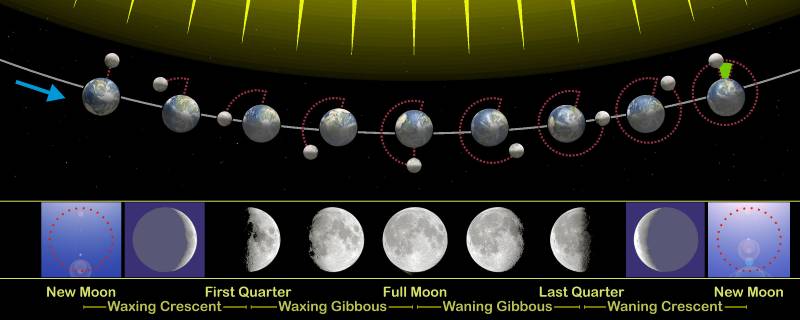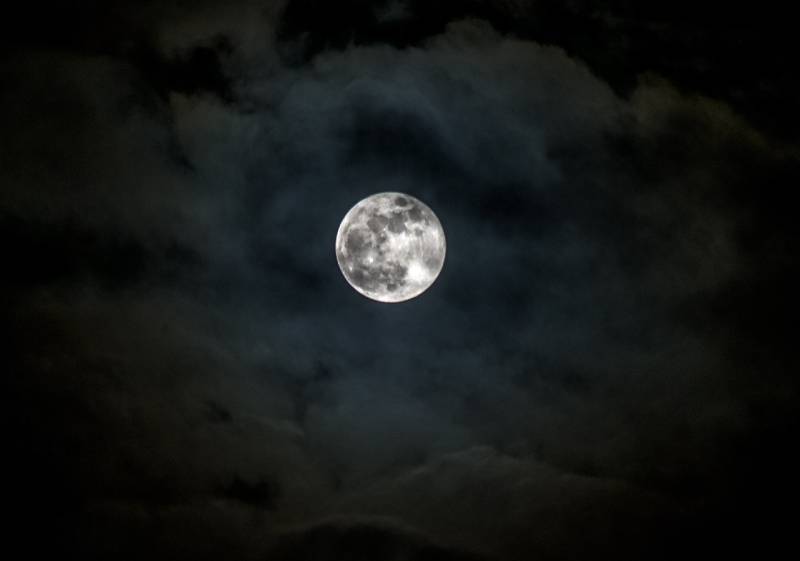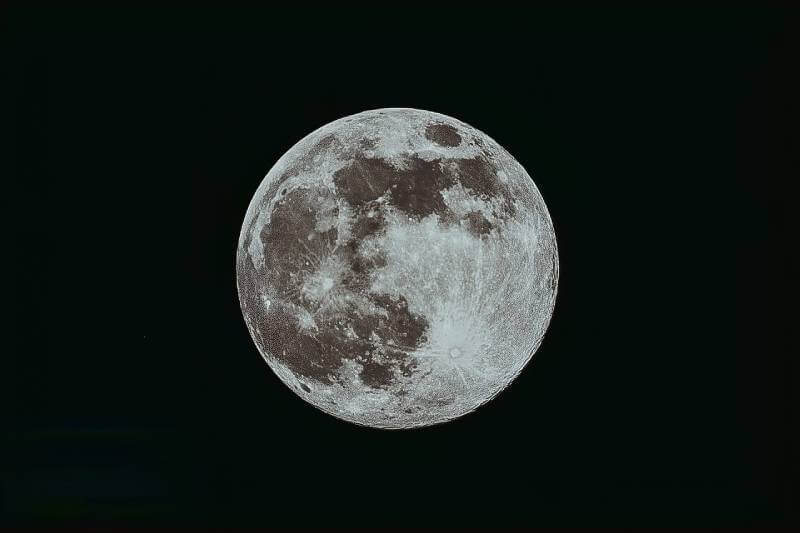A full moon is when we see the entire moon in the night sky. It is one of the phases and it appears about once a month (29.5 days), and the full moon will be seen for 2-3 days. The full moon is between the moon phases of waning gibbous and waxing gibbous.
The moon has 8 phases that require 29.5 days to get through. It starts with the new moon (the moon will appear completely invisible), and then it will end with the waxing crescent (only a sliver of the moon is shown and the rest is invisible).
Synchronized Dance Between the Earth and the Moon
The moon and the Earth are what is called tidally locked. The Earth and the moon became tidally locked shortly after the moon was formed and was caught in the Earth’s orbit. Tidally locked means that we are perfectly synchronized with the moon and we are only able to see one side of the moon.
As we rotate, we only see the same side. The moon orbits around the Earth at almost the exact same pace as the Earth rotates. Since the moon is consistently orbiting around the Earth and we are consistently orbiting around the sun, we get consistent phases.
The Dark Side of the Moon
Although we have referred to the “other side of the moon” as the “dark side,” it is actually not dark at all and receives just as much light as the side that we always see. Not only that, but the other side also goes through phases just like the front side does.
The other side of the moon hasn’t been researched as much as the front side, but we have learned a few key points about the other side. We know that the other side gets hit with space objects more and also has a slightly different chemical composition.
The Moon’s Phases
There are eight phases that the moon goes through in a 29.5-day lunar cycle. The moon begins with the new moon and then ends with the waxing crescent.

The eight phases of the moon include:
● New Moon: When the moon is positioned between the Earth and the sun, with the side of the moon illuminated by the sun facing away from Earth, rendering the moon virtually invisible from our perspective.
● Waning Crescent: When the moon is only showing a little sliver and the rest is invisible.
● Third Quarter: When the moon is showing half of the moon and the other half is invisible.
● Waning Gibbons: When almost ¾ of the moon is showing and there is just a little sliver of the moon that is invisible.
● Full Moon: A full moon is a lunar phase that occurs when the moon is positioned on the opposite side of the Earth from the sun, resulting in its fully illuminated face being visible from Earth, creating a brilliant and complete circle in the night sky.
● Waxing Gibbous: The moon is like the waning gibbous, but the opposite side is illuminated.
● First Quarter: The moon is like the third quarter moon except for the opposite side, which is illuminated.
● Waxing Crescent: The moon is like the waning crescent, except the opposite is illuminated.
The Full Moon
Although the phases are consistent in terms of progression, it is not consistent in terms of days. This means a full moon will not occur every month on a specific date and will not appear for the same length every single month.

The lunar month is 29.5 days, which is pretty close to our months. However, it isn’t exact. In a leap year, one month is 29 days, some months are 30, and some are 31. Therefore, it would be impossible for the moon to show a full moon on, say, the 15th of every month. It changes every single month, so it is a little difficult to predict.
A full moon will appear approximately 15 days after a new moon. So, if you notice a moon that is completely invisible, then you can assume that the full moon will happen about 15 days later.
The Appeal of the Full Moon
Many people are fascinated with the full moon and are superstitious about its effects. Parents and teachers will blame the full moon on overactive children. The full moon is thought to create restlessness, mood swings, and even sleep disturbances.
The full moon superstitions even go beyond how the moon affects humans. People also believe that their animals begin to act up when there is a full moon, causing them to be more sensitive, aggressive, or more ornery than normal.
In many cultures, they believe that the full moon is related to supernatural activity such as werewolves and other shape-shifting creatures that emerge during the full moon.
Many cultures have specific rituals or traditions associated with the full moon. Full moon ceremonies, moonlit gatherings, and prayers are observed in various societies to harness its energy and seek blessings.
No Scientific Evidence
Although there are many superstitions and beliefs surrounding the full moon, there is no solid scientific evidence to support any claims of it changing behavior in humans and animals.
The full moon does, however, have a significant impact on tides due to the increased gravitation pull. During the full moon, the high tides are extremely high, while the low tides are very low.
Future Exploration and Studies of the Moon
The moon has been a point of investigation for centuries. Scientists and researchers are constantly trying to figure out new information about the moon and to answer our many questions.
NASA has created the Artemis Mission that will send astronauts up to the moon again and allow us to learn more about the moon. The program will begin to set up a self-sustaining colony that will provide astronauts the chance to live on the moon for an extended period of time. This will allow them to learn much more and conduct experiments.
It will be really interesting to see if they figure out more fascinating information about the moon phases.

